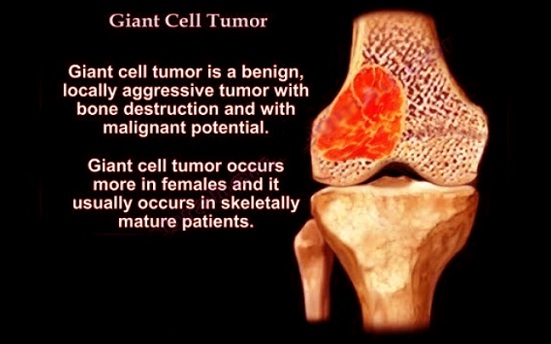Study Uncovers Hidden Cellular Communication Driving Giant Cell Bone Tumors and Link to COVID-19 Related Pathways
Nikhil Prasad Fact checked by:Thailand Medical News Team Apr 21, 2025 2 hours, 30 minutes ago
Medical News: In a groundbreaking new study, researchers from the People’s Hospital of Pingyang County and the Wenzhou Hospital of Integrated Traditional Chinese and Western Medicine in China have mapped the complex internal world of giant cell tumors of bone (GCTB) using a powerful technique known as single-cell RNA sequencing. Their findings have not only revealed intricate cell signaling networks and key tumor-driving genes but have also uncovered surprising links to COVID-19-related biological pathways.

Giant cell tumor of bone is a rare but aggressive tumor that primarily affects young adults. Although it is considered non-cancerous, it is notorious for destroying bone tissue and frequently returning even after treatment. Traditional approaches like surgery and radiation often fall short of offering a permanent cure. This
Medical News report delves into how the latest gene sequencing technologies are now helping scientists understand the inner workings of these tumors at a level of detail never seen before.
Unmasking Tumor Complexity with Single Cell Precision
By analyzing thousands of individual tumor cells from GCTB patients, the researchers were able to identify not only what genes were active in each cell, but how those cells were communicating with each other. Their method allowed them to precisely determine the gene activity of different cell types, including immune cells like macrophages and T-cells, structural cells like fibroblasts, and even cancer-associated fibroblasts (CAFs)—a group of cells now known to play a key role in tumor growth and resistance to treatment.
The scientists found that certain cell types within the tumor were working together through chemical messages, almost like a secret conversation. At the center of this cellular chatter was a molecule called SPP1 (osteopontin), which formed a strong feedback loop between cancer-associated fibroblasts and immune cells. This communication loop appears to help tumors grow and possibly avoid immune attacks.
Surprising Links to COVID-19 and Brain Disorders
One of the most surprising revelations from the study came during the gene pathway enrichment analysis. When scientists examined which known disease pathways the tumor’s gene activity resembled, COVID-19 stood out among the top three—alongside pathways involved in Parkinson’s disease and prion diseases. This unexpected overlap suggests that some of the body’s cellular responses to viral infections may be hijacked by tumor cells to aid their own survival and growth.
These connections to neurodegenerative and infectious diseases open up intriguing possibilities for future research. Could a better understanding of viral response mechanisms lead to new ways to target aggressive tumors like GCTB? The researchers believe this line of investigation is worth pursuing.
Key Genes That Fuel the Tumor Engine
The study also pinpointed several key genes that were significantly overactive in specific cell types within the tumor. For example, the gene RABAC1 showed extremely high exp
ression in a rare subpopulation of tumor cells, suggesting it could play a role in maintaining the tumor's structure or growth. Other genes such as SNAI2, EIF2AK2, and ADAM12 were also flagged for their elevated activity, particularly in relation to how the tumor interacts with the surrounding immune system.
The team used advanced computer models to build visual maps of how all these genes and cells were interacting. These network diagrams and heatmaps helped identify which cells were sending or receiving specific chemical messages, and how strong those interactions were. In particular, the SPP1 signaling network showed dominant communication patterns that could be disrupted in future treatment strategies.
New Pathways to Targeted Treatments
What makes this research especially promising is the opportunity it creates for precision medicine. Instead of treating the tumor as one large mass, doctors could soon target specific cell types or signaling pathways that are crucial for the tumor’s survival. For instance, blocking the SPP1 feedback loop or interrupting specific ligand-receptor interactions between cancer and immune cells might offer a novel route to stop the tumor from growing.
The researchers suggest that these findings could also help develop biomarkers—specific genes or proteins that could be used to detect the tumor earlier or predict how it might respond to certain treatments. Moreover, since some of the same cellular signals appear in both tumors and viral infections, there is potential to repurpose existing antiviral or anti-inflammatory drugs for use in bone tumor patients.
A Step Toward Personalized Cancer Therapies
The conclusions of the study emphasize the importance of understanding each tumor on an individual level. The authors stress that future treatment plans for GCTB could be far more effective if tailored to the unique cellular makeup and signaling patterns of each patient's tumor. This individualized approach, supported by high-resolution techniques like single-cell sequencing, may represent the next evolution in cancer therapy.
While further laboratory validation and clinical trials are needed to translate these discoveries into real-world treatments, this study lays a strong foundation. It also highlights the power of single-cell RNA sequencing not just as a research tool, but as a potential clinical asset in diagnosing and combating complex diseases like giant cell tumors of bone.
The study findings were published in the peer reviewed journal: Discover Oncology.
https://link.springer.com/article/10.1007/s12672-025-02353-1
For the latest Cancer News, keep on logging to Thailand
Medical News.
Read Also:
https://www.thailandmedical.news/news/breaking-macrophage-induced-protein-spp1-identified-as-driving-multiple-pathogenic-inflammatory-responses-in-severe-covid-19-and-long-covid
https://www.thailandmedical.news/news/new-concerns-about-bone-health-after-covid-19
https://www.thailandmedical.news/news/scientists-alarmingly-discover-that-covid-19-disrupts-osteoblast-differentiation
https://www.thailandmedical.news/articles/cancer
https://www.thailandmedical.news/pages/thailand_doctors_listings
